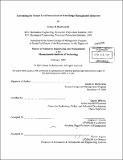Accounting for system level interaction in knowledge management initiatives
Author(s)
Bartkowski, Glenn D. (Glenn David), 1970-
DownloadFull printable version (5.784Mb)
Other Contributors
System Design and Management Program.
Advisor
Daniel Whitney.
Terms of use
Metadata
Show full item recordAbstract
An overview of the operation of a modem, high bypass ratio, dual spool turbofan engine is presented to identify the multitude of system level interactions that must be considered when developing such an engine. The Design Structure Matrix (DSM) is used to demonstrate how it maps these relationships and, if utilized in the right manner, can reduce the occurrence of escapes (i.e., a deliverable that does not meet customers' expectations). The context of this thesis is the complex system design, and development process, of a commercial aircraft gas turbine engine (specifically the Pratt & Whitney PW4000 engine family). Unlike previous gas turbine engine DSM work, the matrix created in this thesis is generated from the point of view of the Systems Engineering organizations at Pratt & Whitney. The sequenced matrix captures the non-local knowledge that is currently absent from Pratt & Whitney's existing knowledge management documentation. Testing the DSM against past instances of rework and unexpected design issues substantiates its validity as the basis for performing this function. Finally, examples are presented to demonstrate how the DSM can be used to prevent future escapes.
Description
Thesis (S.M.)--Massachusetts Institute of Technology, System Design & Management Program, 2001. Includes bibliographical references (leaves 68-69).
Date issued
2001Department
System Design and Management Program.Publisher
Massachusetts Institute of Technology
Keywords
System Design and Management Program.